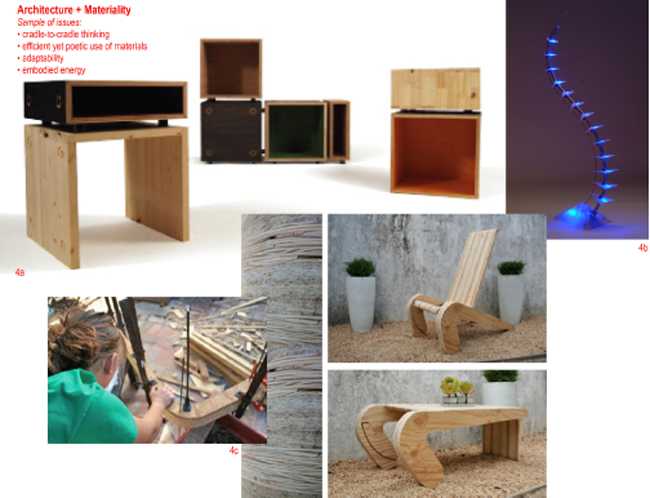Seven Frames of Reference
Senior Architectural Design Projects
Architecture + Materiality

Design Performance Objective |
Architecture + Materiality
Cradle-to-cradle thinking; efficient yet poetic use of materials; adaptability; embodied energy
4a: Adaptable storage furniture, constructed from a minimal materials palette. Material exploration of the ideas surrounding the design of a design/build HIV clinic for South Africa. [David Aine, Matt Ridenour]
4b: LED luminaire, Simultaneous energy efficient and poetic light exploration of the ideas surrounding a transit hub for Santa Barbara, CA. [Kelly Teich]
4c: Adaptable furniture, constructed from a minimal materials palette. Material exploration of the ideas surrounding a thesis about an eco-education center. [Brooke Balachey]
|
Students: as noted |
| Software / Tools: |
none |
|
Arch 481 Senior Architectural Design Project Studio/
Arch 492 Senior Design Thesis Seminar
Architecture + Materiality
Philosophy
Materials are the basic building blocks of an architect’s language. Exploring the poetic potential of structure and materiality is the goal here. Further, it is our responsibility to understand the pivotal cradle-to-grave-to-cradle issues related to material choices, with consideration for the energy consumption involved in extraction as well as recycling. Thus, a designer manipulating any given palette of materials must balance issues of material source with appropriate and inspiring form and structure.
Design Performance Objective
In the initial stages of their thesis development (while students are heavily engaged in writing and research), students are challenged with a 4-6 week “materials” charrette in which they are asked to design and construct a usable object that reflects some of the ideals that they are pursuing in their theses.
• course and project outline
|
Investigative Strategy |
Multiple iterations of physical modeling at a variety of scales. Broad consideration of materials encouraged. Discussion of all appropriate material, design, and design detail aspects: strength, durability, beauty, meaning, embodied energy, cradle-to-cradle issues, etc.
|
Evaluation Process |
|
Final finished object submitted to local furniture competition and shown with thesis at every critique and exhibition.
|
Evaluative Criteria |
Full scale realization project. Design, construction, and exhibition of the final materials study (in the form of a usable object).
|
Cautions - Possible Confusions |
|
Range of Applicability in terms of CLIMATE |
ALL |
Range of Applicability in terms of TYPE |
ALL |
Reference Material (Partial List) |
Precedent studies as they relate to the individual projects.
McDonough, William and Michael Braungart, Cradle To Cradle: Remaking the Way We Make Things (New York: North Point Press, 2002).
|
Duration of Exercise |
4-6 weeks.
|
Degree of Difficulty / Previous Knowledge Required |
Varies with type of project/artifact selected.
|
| |
![Table of re-used and found lumber exploring beauty and celebrating material performance. A materials exploration for a thesis involving the design of a retreat space in an extreme mountain climate. [Ion Webster]](../../teaching/stannard/images/IMG_0078_resize.JPG)
Table of re-used and found lumber exploring beauty and celebrating material performance. A materials exploration for a thesis involving the design of a retreat space in an extreme mountain climate. [Ion Webster]
|
|
|
|

